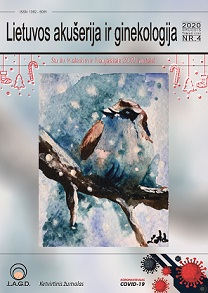INFLUENCE OF MATERNAL OBESITY ON LABOR INDUCTION AND OUTCOMES
Abstract
Objective. The aim is to evaluate the influence of obesity on labor induction and outcomes. Methods. The case-control study was carried out retrospectively using the data from the Department of Obstetrics and Gynaecology of the LithuanianUniversity ofHealth Sciences Birth Registry from 2018.We analyzedmaternity and medical history records of 509 women who had induction of labor: 114 were obese and 395 had normal weight. Patients demographics, methods and indications of induction of labor, complications of pregnancy, delivery mode, labor length and neonatal characteristics including birthweight and Apgar score were analyzed. Results. Gestational diabetes was diagnosed in 51.8% of obese and in 17.5% normal weight women (P<0.001). Labor induction was performed in 18.4% of obese and in 6.6% of normal weight women, (P<0.001). Gestational diabetes was diagnosed in 30.7% and in 16.2%, P=0.001), pregnancy induced hypertensive conditions in 14.9% and 4.0% (P<0.001) and fetal distress in 5.3% and 1.5% (P=0.031) of obese and normal weight women, respectively. Labor induction was performed in 29.9% of obese and in 14.9% of normal weight women because of prolonged pregnancy (P<0.001), in 9.9% and 2.6% (P=0.013) because of intrauterine fetal growth restriction, in 7.1% and 0.9% (P=0.012) because of prelabour rupture ofmembranes of obese and normal weight women, respectively.Women with normal body weight induced with prostaglandins were found to havemean of Bishop score 3.4 (SD 1.13) compared to obese women 4.28 (SD 1.07) (P<0.001). Second stage of labor of normal weight women lasted for 65.5 (SD 69.87) min. compared to 41.0 (SD 54.18) min. in obese women (P<0.001). In case of labor induction with prostaglandins first stage of labor in normal weight women lasted 555.2 (SD 343.57) min. and 442.4 (SD 353.57) min. in obese women, (P=0.035), second stage – 79.3 (SD 76.92)min. in obese and 53.5 (SD 72.29)min. in normal weight women (P=0.007). When amniotomy was performed second stage of labor lasted 58.8 (SD 64.18)min. in normal weight and 32.4 (SD 41.19) min. in obese women (P=0.004).Using oxytocin for induction of labor first stage of labor in obese and normal weight women lasted 548.0 (SD 248.94) min. and 346.4 (SD 183.29) min. (P=0.037). Caesarean section was performed in 66.7% and 13.6% because of failed induction of labor (P<0.001), in 16.7% and 30.5% because of fetal distress (P<0.001), in 16.7% and 42.4% (P<0.001) because of narrow pelvic outlet and in 0% and 13.6% because of failure to labor progress (P<0.001) of obese and normal weight women, respectively.Median Apgar score at 1 minute was 9.0 (6–10) in obese women and 9.0 (3–10) in normal weight women newborns (P=0.001), at 5 minutes – 10.0 (7–10) and 10.0 (7–10) (P=0.03), respectively.Mean birth weight was 3605.9 (SD 516. 40) and 3492.8 (SD 527.25), (P=0.027) in obese and normal weight women, respectively. Large for gestational age newborn was found in 20.2% of obese and in 11.4% of normal weight women (P=0.015). Conclusions. Obese women more often experienced induction of labor because of preeclampsia, gestational diabetes, pregnancy induced hypertensive conditions and fetal distress, caesarean section more often performed because of failed induction of labor. When using oxytocin for induction obese women had longer first stage of labor. Gestational weight of newborns of obese women with inducted labor was higher, Apgar scores were also lower.

